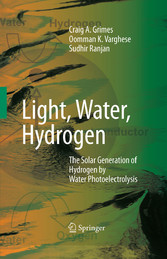Suchen und Finden
Mehr zum Inhalt

Light, Water, Hydrogen - The Solar Generation of Hydrogen by Water Photoelectrolysis
Foreword
5
Preface
12
Acknowledgment
14
Contents
15
Chapter 1 FROM HYDROCARBONS TO HYDROGEN: TOWARDS A SUSTAINABLE FUTURE
21
1.1 Introduction
21
1.2 Hydrogen: A Historical Perspective
27
1.3 Renewable Energy and Hydrogen
30
1.4 The Energy Carriers: Hydrogen or Electricity?
32
1.5 Hydrogen as a Chemical Fuel
35
1.6 The Hydrogen Economy
37
1.7 Hydrogen Production [20]
38
1.8 Hydrogen and Transportation
44
1.9 Environmental Effects of Hydrogen
48
1.10 Hydrogen Storage
48
1.11 Hydrogen Safety
49
References
50
Chapter 2 HYDROGEN GENERATION BY WATER SPLITTING
54
2.1 Introduction
54
2.2 Hydrogen Production By Water Electrolysis
54
2.3 Hydrogen Production by Thermochemical Water- Splitting
71
2.4 Hydrogen Production By Water Biophotolysis
86
2.5 Other Techniques for H2 production via Water Splitting
103
References
112
Chapter 3 PHOTOELECTROLYSIS
133
3.1 General Description of Photoelectrolysis
133
3.3 Types of Photoelectrochemical Devices
141
3.4 Photoelectrolysis Principles
143
3.5 Photoelectrochemical Cell Band Model
170
3.6 Efficiency of Water Splitting in a Photoelectrochemical Cell
175
References
197
Chapter 4 OXIDE SEMICONDUCTING MATERIALS AS PHOTOANODES
209
4.1 Introduction
209
4.2 Photoanode Reaction Mechanisms
210
4.3 General Description of Oxide Semiconductor Photoanodes
214
4.4 Single Crystal Materials as Photoanodes
217
4.5 Polycrystalline Photoanode Materials
224
4.6 Thin Film Photoanode Materials
227
4.7 Nanocrystalline and Nanoporous Thin Film Materials as Photoanodes
237
4.8 Quantum-size Effects in Nanocrystalline Semiconductors
249
References
260
Chapter 5 OXIDE SEMICONDUCTORS: NANO- CRYSTALLINE, TUBULAR AND POROUS SYSTEMS
274
5.1 Introduction
274
5.2 Synthesis of Nanotubular Oxide Semiconductors
276
5.3 Fabrication of Titania Nanotube Arrays by Anodization
285
5.4 Doped Titania Nanotube Arrays
314
5.5 Material Properties
319
5.6 Optical Properties of Titania Nanotubes Arrays
328
5.7 Photoelectrochemical and Water Photolysis Properties
340
5.8 Ti-Fe-O Nanotube Array Films for Solar Spectrum Water Photoelectrolysis
355
References
370
Chapter 6 OXIDE SEMICONDUCTORS: SUSPENDED NANOPARTICLE SYSTEMS
387
6.1 Introduction
387
6.2 Nanoparticle-Based Photocatalytic Water Splitting
390
6.3 Nanoparticle Synthesis Techniques
392
6.4 Synthesis of Complex Oxide Semiconductors
401
6.5 Design of Oxide Semiconductors
403
6.6 Conclusions and Future Prospects
426
References
427
Chapter 7 NON- OXIDE SEMICONDUCTOR NANOSTRUCTURES
443
7.1 General Description of Non-Oxide Semiconductors
443
7.2 General Synthesis Techniques of Non-Oxide Semiconductors
449
7.3 Non-Oxide Photoelectrode Systems and Water Photoelectrolysis
457
7.4 Non-oxide Suspended Particle Systems and Direct Water Splitting
471
7.5 Concluding Remarks
481
References
481
Chapter 8 PHOTOVOLTAIC - ELECTROLYSIS CELLS
500
8.1 Introduction
500
8.2 General Description of Solar Cell Technology
501
8.3 PV-Electrolysis Systems for Hydrogen Production [ 1- 34,41,43,87- 92]
514
8.4 Multi-junction PV Tandem Cells for Hydrogen Production [ 35- 39,44,45,93- 101]
516
References
522
Index
532
Alle Preise verstehen sich inklusive der gesetzlichen MwSt.





















